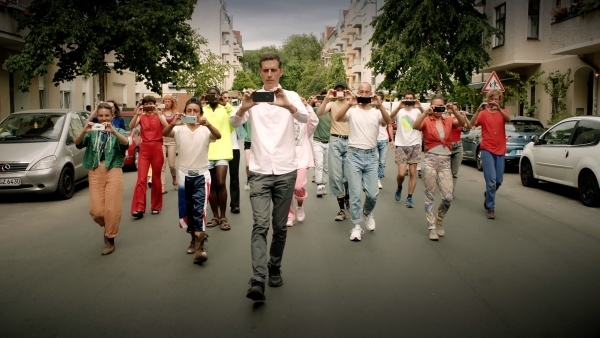News 20 February 2020
FIRST PERSON PLURAL - the exhibition
For five days in April, Osnabrück will once again be a meeting place for artists, curators, distributors and students. This year, the festival has the motto FIRST PERSON PLURAL. This is also the title of the exhibition at the Kunsthalle Osnabrueck, curated by Inga Seidler and Hermann Noering, which opens on 22 April at 7.30 pm.
To define one's own self, the individual is always dependent on others. It needs a counterpart or an audience with whom it can identify or from whom it can distance itself. Therefore, it can hardly be regarded as a closed subject, but rather as a collection of different 'we'. The artistic positions gathered in the exhibition approach this ecology of relationships in different ways. They include non-human actors and new technologies through which identity is created.
In her video work 'You are boring!', for example, Vika Kirchenbauer has a group of performers analyse, present and portray themselves - in relation to exclusion, sell-out and discrimination of people in the art world.
While Kirchenbauer's 'we' is described by the affiliation or exclusion of a certain group of people, Barbara Kapusta's sculptural work 'The Giant' begins directly with the body or with a body dismantled into its individual parts. Scattered throughout the exhibition rooms are groups of alienated limbs, organs and tentacle-like body parts. In oversized speech bubbles, the organic parts, speaking for a whole, address the viewer. "In the case of dangerous bodies, it should ultimately be about empathy and solidarity. How far can we imagine the needs and wishes of other bodies? With whom and how many can we identify? Who do we define as sufficiently valued for our solidarity" Kapusta asks in her work. 'The Giant' places the visitors within this scene, entangles them and makes them part of the whole.
James Bridle's latest film 'Se ti sabir' is about the relationship of humans to new intelligent technologies, language and other non-human species. In it, the artist tries to imagine new ways in which not only people can learn to understand each other across linguistic boundaries, but also the beings with whom they share their living space and those they have created themselves.
The artists' collective Lou Cantor is developing a new work for the festival in which it speculates on the possibilities of an empathic approach between artificial intelligence and the human 'we'.
Visitors will also encounter avatars and artificial figures such as the 'SelfSisters' of the artist Johannes Paul Raether, whose individual identities form separate research units within his 'identity architecture'. As potential identities they structure the performance system, which Raether has been continuously expanding since 2008.
Erica Scourti's artistic work focuses on the individual, publicly available self, mixing performance art, self-experimentation and therapy, autobiographical writing, digital archiving and code. Scourti regards the 'I' as a "socially networked experience" and traces how machines and algorithms today influence and participate in the self-constructions of users.
Clemens von Wedemeyer's work 'Transformation Scenario' is about algorithms that were developed in the film and games industry to simulate crowds of people, but which could also be used in the future to control the crowd. Following the author Elias Canetti, he asks why and in which situations crowds can be controlled by individuals. At the same time, the work directs attention to the potential of demonstrations and mass events as moments of resistance.
Christian Falsnaes' artistic interest also focuses on groups, their internal processes, hierarchies and structures of power, which he considers especially in the context of pop-cultural phenomena. Through the active involvement of the audience, who follow the instructions of a leading figure, the boundaries of group euphoria are sounded out and the willingness to subordinate oneself to authority is examined in a laboratory setting. In 'Goals' this happens in a very ambivalent way: on the one hand, the work promotes the sustainability goals of the United Nations, on the other hand, with her choreography of a collective, she questions the mobilizing character of these popular calls for behavior.
The science fiction documentary 'Lumapit Sa Akin, Paraiso (Come to Me, Paradise)' by Stephanie Comilang focuses on the social life of her protagonists: Filipino home helpers in the Hong Kong of the future. A drone, which transports videos and messages recorded by the women, forms the central possibility of connecting with each other on the one hand and of making contact with the families in the distance on the other.
The exhibition of the European Media Art Festival combines reflection on current identity issues with the question of how digital communication technologies influence self-presentation and perception. Furthermore, it is about the means used for 'we' formation and the consequences that can be derived from this - especially in times of populism and exclusion.
We cordially invite you to visit the 33rd European Media Art Festival and be present at the opening on 22 April at 7.30 pm in the Kunsthalle Osnabrueck.
With best regards
The team of the European Media Art Festival 2020
